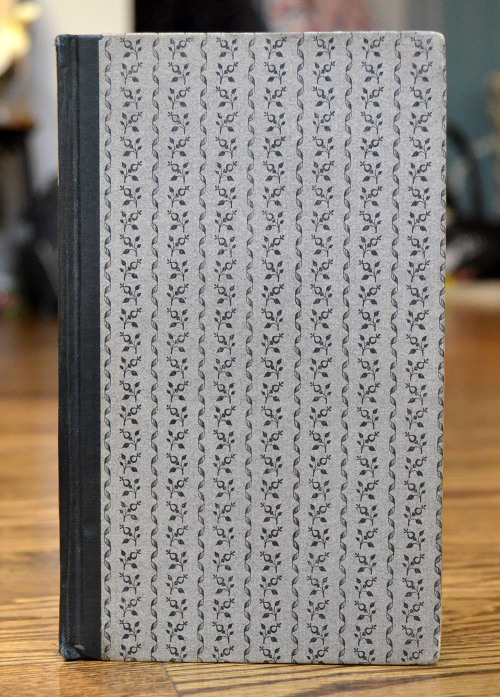Catalogue No. 8 (E-List) - Recent Acquisitions (March 2020)
Note: There are no other copies available for sale (at the time of posting) of any volume included in this list.
How to order
Email: underthehillbooks@gmail.com
Terms of payment
All major credit cards and Paypal accepted. Please inquire if further details are needed. Items may be returned for any reason, upon notification by email, within seven days of receipt (return shipping is the responsibility of the customer). Libraries and institutions may apply for deferred billing.
Terms of shipping
Postage is additional, and items can be shipped via USPS or UPS.
One of the most striking book cover designs produced at Copeland & Day
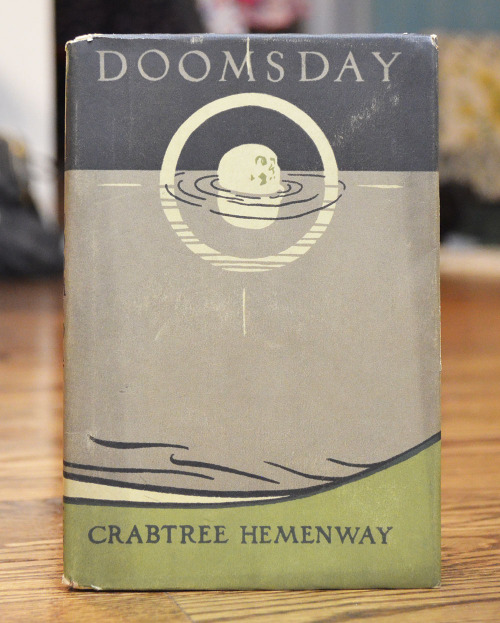
1) Hemenway, Crabtree [Myles]. Doomsday. Boston: Copeland & Day, 1898. First edition. Printed by the University Press, Cambridge. Bound in pictorial light yellow paper wrappers over boards. “[A] memorably vivid graphic appeared on the Copeland and Day issue entitled Doomsday, a fantasy by Myles ‘Crabtree’ Hemenway. The haunting image of a skull in a circle floating on the sea was created by Henry Hunt Clark (a graduate of MIT and later the head of the decorative design department at the Rhode Island School of Design) but was incorrectly attributed to the book’s author” (Fanning). Measures approx. 4.75" x 7". Some rubbing to edges and spine tips. A beautiful example of a volume that is very rarely encountered.
“In ‘Doomsday,’ by Crabtree Hemenway, which Copeland & Day published several months ago, we have a very remarkable book. It is remarkable chiefly for its beautiful writing and its cover design. This cover is easily the oddest of the year…” (New York Times, 1899).
SOLD
Scarce volume featuring Bertram Grosvenor Goodhue decorations
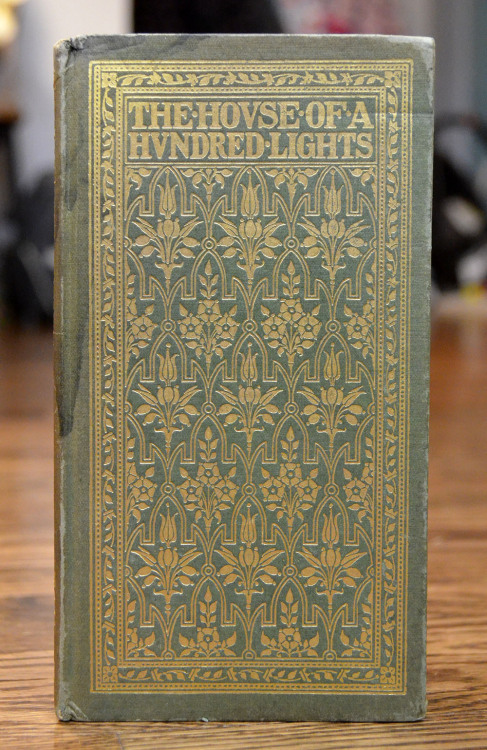
2) Torrence, Frederic Ridgely. The House of a Hundred Lights. Small, Maynard & Company, 1900. Printed at the Heintzemann Press, Boston. Limited edition of 750 copies. Green paper-covered board with ornate gilt design by Bertram Grosvenor Goodhue to the front cover. Same design in blind to the rear cover. Striking endpapers in green & gilt. Title page ornament, decoration to the first and last pages of text, and colophon ornament all by Goodhue. Measures approx. 4" x 7.25". Covers have some rubbing to edges and dampstain to upper 1/3 of the volume near the spine. Pages have dampstain in similar area.
SOLD
One hundred initials and seven full page borders by Goodhue

3) [Maynard, Laurens, editor]. Latter-Day Love Sonnets. Small, Maynard & Company, 1907. Limited edition of 750 copies.Features seven borders, one hundred initials, and title page ornament, all designed by Bertram Grosvenor Goodhue. Grey paper covered boards with Japan vellum corners and spine, titled in gilt. Measures 6" x 8". Some light rubbing to edges and corners, a few marks to covers, and light browning to spine.
SOLD
Private printing from the Merrymount Press, with Dwiggins title page design
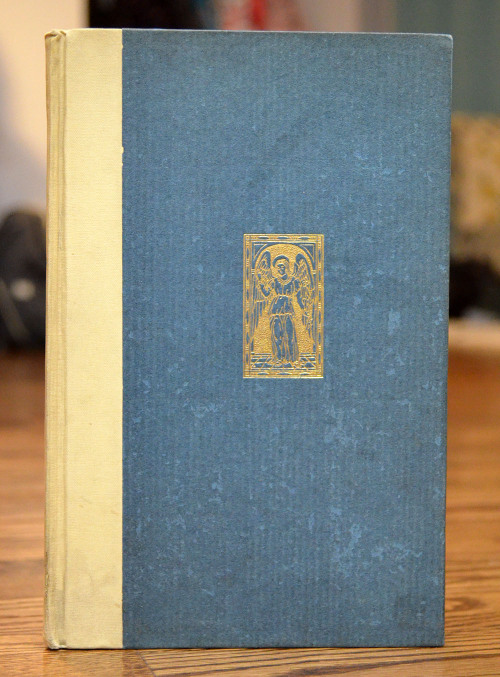
4) White, Grace Hoffman. Christus. Privately printed by D.B. Updike at The Merrymount Press, 1909. Inscribed by the author, with a handwritten copyright slug by her on the rear of the title page. The title page was designed by W.A. Dwiggins. Blue paper-covered boards with angel stamped in gilt to front cover, and cream cloth spine with gilt lettering. Measures approx. 5.5" x 8". Some marks and light rubbing to covers. Smith 334.
SOLD
Scarce volume from the Merrymount Press, limited to 112 copies
5) The Course of True Love in Colonial Times: Being the Confessions of William Palfrey of Boston and the Friendly Advice of Moses Brown of Providence Concerning Polly Olney. Boston: The Merrymount Press, 1905. Limited to 112 copies. Printed for I.B. Richman and George Parker Winship. Printed on Alton Mill uncut paper. Grey patterned paper covered boards with black cloth spine and paper label. Bookplate on front pastedown of Henry Dexter Sharpe. Measures approx. 4.75" x 7.5". Bumping to corners, light rubbing. Smith 210.
SOLD
Early cocktail book printed by Updike at the Merrymount Press

6) Bigelow, Timothy, editor. A Book of Beverages, Being Recipes Secured from Those Housewives Most Notable for Their Skill in the Preparation of Choice and Delectable Beverages for Winter Nights and Summer Noons. Worcester, MA: Printed by D.B. Updike at The Merrymount Press for Timothy Bigelow and The Daughters of the American Revolution, 1900. The borders in the volume were originally used in volumes printed by Isaiah Thomas. Chapters include: Beers, Ciders, Cordials, Fruit Cocktails, Iced Drinks, Punches, Mulled Wines, Wines, etc. Bound in plaid paper-covered boards with green cloth spine and paper label to front cover. Measures 4.5" x 7.5". Slight rubbing to edges and light browning to covers. Smith 203.
SOLD
The first book printed by the Roycroft Shop, limited to 12 copies on Japan Vellum: “…the rarest book of the press…

7) Song of Songs: Which is Solomon’s. The Roycroft Printing Shop, 1896. Limited to 12 copies on Japan Vellum, of which this is #11. Inscribed by Elbert Hubbard to Dr. J.M. Thompson. Two-color title page designed by Bertha Hubbard. Printed on Ruisdael handmade paper. Bound in grey paper-covered boards, with gilt title to front cover, and cream buckram spine. Original prospectus loosely inserted. Measures approx. 6 x 9.25”. Bookplate of Herman M. Schroeter to the front pastedown. Some rubbing to edges, bumping to corners, and spots to buckram spine.
This was the first book of the Roycroft Press, and “this variant is considered the rarest book of the press…” (Modiano, Roycroft Books).
SOLD
Modeled calf leather binding done by the Roycroft Shop

8) Hubbard, Elbert. White Hyacinths. The Roycrofters, 1907. Limited to 207 copies, of which this is #15. The text body is in Caslon and is printed in 3 colors on Japan Vellum. The title page, colophon, initials, and tailpieces were designed by Dard Hunter. Bound in full modeled calf with a beautiful art nouveau design to the front cover and lettering done by hand. Brown silk doublures surrounded by decoration in blind, silk free endpapers, and marbled paper flyleaves. Top edge gilt. Measures approx 4.5" x 7". Gift inscriptions on rear of marbled endpaper. Wear to covers, hinges worn, rubbing to edges, scratches to rear cover.
SOLD
A striking arts & crafts binding in beautiful condition

9) D'Annunzio, Gabriele. La Citta Morta. Milan: Fratelli Treves, 1898. Second thousand. Bound in full red crushed morocco in the style of The Doves Bindery, featuring a diapered flower and leaf pattern with surrounding gilt dots in diagonals. Spine with raised bands, gilt lettered to one panel, the others with ornate leaves and dots. Gilt ruled inner dentelles with matching floral cornerpieces. Marbled endpapers, all edges gilt. A beautiful copy, with a hint of rubbing at bands.
SOLD
Printed on vellum, in Riviere binding, hand-colored by Gloria Cardew

10) Chatterton, Thomas. The Rowley Poems of Thomas Chatterton [Two vols bound as one]. London: Hacon & Ricketts, The Vale Press, 1898. Limited to 8 copies printed on vellum. Borders of wild bryony by Charles Ricketts in both volumes, with initial letters throughout, all of which have been hand-colored by Gloria Cardew. Original paper leaf signed by Cardew bound in. Owner’s stamp in purple ink of Helen Ladd Corbett on front vellum pastedown. Bound in dark green full morocco by Riviere & Son with a beautiful intertwining arts & crafts design on both covers of flowers, dots, and an inner border of broad inlaid green leaves. Spine features a similar design, and quadruple gilt-ruled dentelles with three gilt flowers at corners. Top edge gilt. Enclosed in a leather backed clam-shell case. Measures approx. 6" x 9.25". Spine faded, some rubbing to edges, and restoration to outer hinges.
SOLD
Bound at the Cuneo Press Fine Binding Studio, likely by Leonard Mounteney
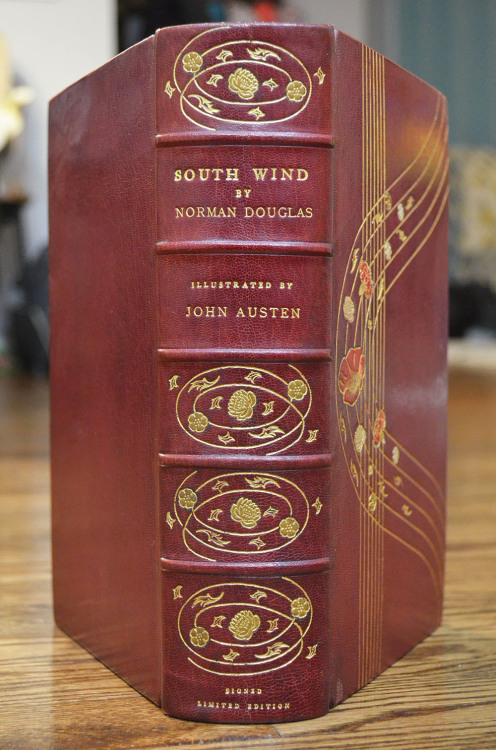
11) Douglas, Norman. South Wind. Argus Books, 1929. Limited to 40 copies, of which this is #7. Each copy of this edition contains an original, unreproduced drawing by John Austen, and is signed by both Austen and Norman Douglas. This copy’s drawing is titled “A Clubman”. The author’s most famous novel, which was originally published in 1917. This edition includes 15 illustrations (of which 5 are colored) and 50 chapter headings by John Austen, specially commissioned. The book is set on an imaginary island called Nepenthe, located off the coast of Italy in the Tyrrhenian Sea, but is clearly a fictionalized version of Capri.
Bound in full crimson morocco by the Cuneo Press Fine Binding Studio, most likely by Leonard Mounteney, who was the finisher at Cuneo at the time this volume was bound in the early 1930s. (The design also features a flower tool that is utilized on a signed Mounteney binding, seen here.) Mounteney worked as an extra finisher at Riviere & Son in London until 1924, when he joined the Extra Bindery at R. R. Donnelley in Chicago, working alongside Alfred de Sauty. He left Donnelley in 1926 to join Cuneo’s hand bindery, also in Chicago.
The front cover design aptly features an art deco representation of a “south wind”, blowing a variety of inlaid flowers in red, white, and orange, and gilt leaves towards the top of the cover. Four of the six spine compartments contain a simplified version of this motif, with a swirling gilt gouge interspersed with inlaid flowers and leaves. Red silk doublures, surrounded by gilt rules and flowers at the corners, and silk free endpapers. All edges gilt. Housed in a red cloth, morocco-tipped case, lined with velvet. Measures approx. 6.75" x 10". Small abrasion to lower left corner of front cover.
SOLD
A stunning illuminated volume in a binding by Mounteney

12) Rubaiyat of Omar Khayyam. Carolon Press, 1908. Limited to 300 copies. Unpaginated [29 pages]. Potter 187. As stated on one of the flyleaves, this volume has been “Illustrated and Illuminated by Dorothy Stuart Hughes” (circa the early 1920s). The paper cover (bound in) has been illuminated, and a tipped-in frontispiece in vibrant watercolors has been added by Hughes, featuring a theatrical example of a woman in Persian garb and flowing veil–a theme repeated throughout. Following the “extra illustrated” frontis is the original opening initial and border from this Carolon Press edition, which have been illuminated in gold, greens, purple, and blues. In addition, this page is the first glimpse at a feature that is present throughout the entire text: letters have been in-filled at regular intervals with orange, green, purple, and turquoise.
The illuminations on the following pages encompass a variety of scenes, and in a sense, words cannot do them justice. Hughes captures a romanticized version of the East and imbues the scenes and figures with an unmistakable sense of the newly independent woman of the 1920s.
Dorothy Stuart Hughes (1897-1965?) was born in Boston, and “…took a one year’s course in the Life Room of the New York School of Applied Design for Women in New York City. From there she took up portrait painting under Joseph Boston at Carnegie Hall. Two summers were spent at Provincetown in the Art Colony studying landscape and oils under George Elmer Browne, and another year was spent at the New School for Life and Illustrations at Boston” (Brooklyn Daily Eagle).
Hughes’ work is most notably included in a variety of materials for The Omar Khayyam Club of America, and it’s quite possible this volume was created in relation to the work she did for the Club, or a Club member. Further examples of her work can be seen in Fitzgerald’s Rubaiyat of Omar Khayyam: Popularity and Neglect (link) and several menu illustrations in Twenty Years of the Omar Khayyam Club (link).
Bound in full blue crushed levant morocco by Leonard Mounteney (circa 1930), with a design reminiscent of arts & crafts designs circa the turn of the century; both covers feature inlaid red roses and gilt leaves at each corner, surrounded by a border of 3 semi-circular gouges, each connected with gilt fillets. Five bands to spine, with gilt tooling in each compartment, title, and five inlaid red flowers. Heavily gilt dentelles built up with roll tools, surrounding red watered silk endpapers. “Mounteney, Finisher” stamped to bottom of rear dentelle. Housed in felt-lined blue cloth slipcase with silk ribbon pull. Measures approx. 5.75" x 9.75".
Likely bound during Mounteney’s tenure with the Cuneo Press Fine Binding Studio. Mounteney worked as an extra finisher at Riviere & Son in London until 1924, when he joined the Extra Bindery at R. R. Donnelley in Chicago, working alongside Alfred de Sauty. He left Donnelley in 1926 to join Cuneo’s hand bindery, also in Chicago.
SOLD

